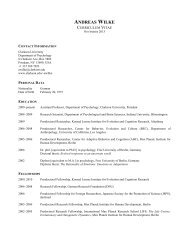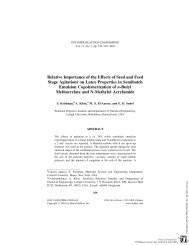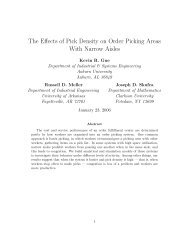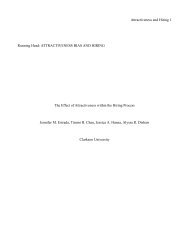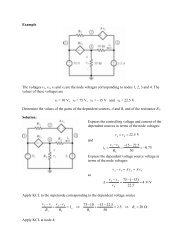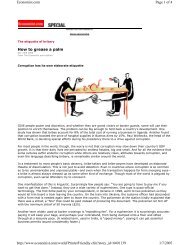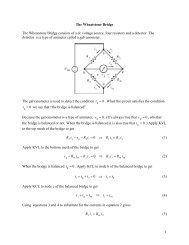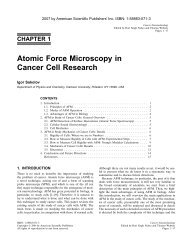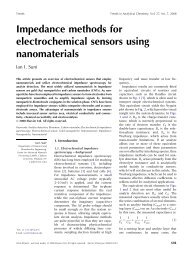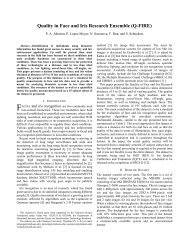Getting a Handle on Advanced Cubic Equations of State
Getting a Handle on Advanced Cubic Equations of State
Getting a Handle on Advanced Cubic Equations of State
You also want an ePaper? Increase the reach of your titles
YUMPU automatically turns print PDFs into web optimized ePapers that Google loves.
Measurement & C<strong>on</strong>trol<br />
the excess Helmholtz energy at infinite pressure from a CEOS<br />
to excess Helmholtz energy calculated from an activity coefficient<br />
model, and they c<strong>on</strong>strained the EOS parameters a and b<br />
to satisfy the sec<strong>on</strong>d-virial-coefficient c<strong>on</strong>diti<strong>on</strong>:<br />
a b x a<br />
E<br />
* * ⎡ *<br />
i 1 A<br />
= ∑ i * +<br />
⎛ ∞ ⎞ ⎤<br />
⎢<br />
( )<br />
⎣ i biC ⎝ RT ⎠ ⎥<br />
24<br />
1 ⎦<br />
n n a<br />
xx<br />
⎛ ij<br />
∑ ∑ i j bij<br />
−<br />
⎞<br />
j ⎝ RT ⎠<br />
i b =<br />
a*<br />
1 − *<br />
b<br />
The W<strong>on</strong>g-Sandler model introduced a binary interacti<strong>on</strong> parameter,<br />
k<br />
ij , to correct the assumpti<strong>on</strong> that the excess<br />
Helmholtz free energy at infinite pressure can be approximated<br />
by the excess Gibbs free energy at low pressure:<br />
b<br />
ij<br />
a<br />
a a<br />
ij 1 ⎡<br />
i<br />
j<br />
− =<br />
⎛<br />
bi<br />
−<br />
⎞ ⎛ ⎞ ⎤<br />
⎢ + bj<br />
− 1 k<br />
RT ⎝ RT ⎠<br />
⎜ ⎟<br />
⎣<br />
⎝ RT ⎠<br />
⎥ −<br />
2<br />
⎦<br />
W<strong>on</strong>g and Sandler dem<strong>on</strong>strated that parameters in the activity<br />
coefficient models correlated at low temperatures can be<br />
used to extrapolate to higher temperatures. Michelsen and<br />
Heidemann (20) suggest that this success is fortuitous.<br />
In an effort to reduce the W<strong>on</strong>g-Sandler mixing rules to the<br />
c<strong>on</strong>venti<strong>on</strong>al van der Waals mixing rules, Orbey and Sandler<br />
(21) modify the G E model <strong>of</strong> NRTL differently. C<strong>on</strong>sequently,<br />
the mixing rules used in their model cannot employ the NRTL<br />
parameters reported in the DECHEMA Chemistry Data<br />
Series.<br />
Twu-Co<strong>on</strong> infinite-pressure mixing rules<br />
Twu and Co<strong>on</strong> (22) used a van der Waals mixture as a reference<br />
to derive the mixing rules for their EOS. These mixing<br />
rules re-define a and b as:<br />
*<br />
E E<br />
* * ⎡avdw<br />
1 A A vdw<br />
a = b * +<br />
⎛ ∞ ∞<br />
−<br />
⎞ ⎤<br />
⎢<br />
( )<br />
b C ⎝ RT RT ⎠ ⎥<br />
27<br />
⎣ vdw 1<br />
⎦<br />
* *<br />
*<br />
bvdw − avdw<br />
b =<br />
( 28)<br />
*<br />
E E<br />
⎡avdw<br />
1 A A vdw<br />
− * +<br />
⎛ ∞ ∞<br />
−<br />
⎞ ⎤<br />
1 ⎢<br />
⎣ bvdw C ⎝ RT RT ⎠ ⎥<br />
1<br />
⎦<br />
C1 in Eqs. 27 and 28 is defined in Eq. 23. The asymmetric van<br />
der Waals mixing rule is applied to the avdw parameter, and the<br />
linear mixing rule is used for the bvdw parameter:<br />
avdw = ∑ ∑ xixj aa i j ( 1−kij)+ i<br />
j<br />
( ) ( − )<br />
⎡<br />
∑ x ⎢∑<br />
x aa k k<br />
i ⎣ j<br />
i j i j ji ij<br />
( j )<br />
bvdw = x x<br />
⎡1<br />
∑ ∑ i j b + b<br />
i j ⎣⎢ 2<br />
⎤<br />
⎦⎥<br />
⎤<br />
⎥<br />
⎦<br />
16 13 3<br />
/ /<br />
( ij )<br />
( 25)<br />
( 26)<br />
( 29)<br />
( 30)<br />
Subscript vdw in AE in Eqs. 27 and 28 denotes that the proper-<br />
∞ vdw<br />
ties are evaluated from the CEOS using the van der Waals mixing<br />
62 www.cepmagazine.org November 2002 CEP<br />
rule for its a and b parameters as given by Eqs. 29 and 30.<br />
The Twu-Co<strong>on</strong> mixing rules reduce to the van der Waals<br />
mixing rules if AE ∞ = AE . It is extremely desirable that the<br />
∞ vdw<br />
compositi<strong>on</strong>-dependent mixing rules reduce to the classical<br />
mixing rules because the latter work very well for n<strong>on</strong>-polar<br />
systems. The use <strong>of</strong> asymmetric parameters, k and k ,im-<br />
ij ij<br />
proves the accuracy <strong>of</strong> the reproducti<strong>on</strong> <strong>of</strong> the liquid-activity<br />
coefficients. Although it may be more accurate to simply refit<br />
the GE parameters in the mixing rules instead <strong>of</strong> introducing<br />
two new parameters, k and k , to match the results <strong>of</strong> the ac-<br />
ij ij<br />
tivity coefficient model, doing so would sacrifice the extrapolati<strong>on</strong><br />
ability <strong>of</strong> the infinite-pressure approach. Furthermore,<br />
the original idea <strong>of</strong> using directly published parameters for activity<br />
coefficient models in the equati<strong>on</strong> <strong>of</strong> state will be lost.<br />
Twu-Sim-Tass<strong>on</strong>e infinite-pressure mixing rules<br />
It is a challenge to find a general expressi<strong>on</strong> for AE ∞ that<br />
can be simplified to AE in the Twu-Co<strong>on</strong> infinite-pressure<br />
∞ vdw<br />
mixing rules (Eqs. 27 and 28). As menti<strong>on</strong>ed previously,<br />
Orbey and Sandler modified the GE model <strong>of</strong> NRTL to a different<br />
form to reduce the W<strong>on</strong>g-Sandler mixing rules to the<br />
c<strong>on</strong>venti<strong>on</strong>al van der Waals mixing rules. Twu et. al. (23) developed<br />
a new excess Gibbs energy functi<strong>on</strong>, which reduces<br />
to the van der Waals <strong>on</strong>e-fluid mixing rule (Eqs. 18 and 19).<br />
The incorporati<strong>on</strong> <strong>of</strong> this new excess Gibbs functi<strong>on</strong> into a<br />
CEOS allows the Twu-Co<strong>on</strong> infinite-pressure mixing rules to<br />
smoothly transiti<strong>on</strong> to the c<strong>on</strong>venti<strong>on</strong>al van der Waals <strong>on</strong>efluid<br />
mixing rules. A general multi-comp<strong>on</strong>ent equati<strong>on</strong> for a<br />
liquid activity coefficient model is proposed by Twu et. al.<br />
(23) for incorporati<strong>on</strong> in the infinite-pressure mixing rules:<br />
E ∑ x τ G<br />
G n<br />
j<br />
= ∑ xi<br />
n<br />
RT i<br />
∑ xG<br />
n<br />
k<br />
j ji ji<br />
k ki<br />
( 31)<br />
Eq. 31 appears to be similar to the NRTL equati<strong>on</strong>, but there<br />
is a fundamental difference between them. NRTL assumes A ij ,<br />
A ij , and α ij are the parameters <strong>of</strong> the model, but the TST excess<br />
Gibbs energy model assumes τ ij and G ij are the binary-interacti<strong>on</strong><br />
parameters. More importantly, any appropriate temperature-dependent<br />
functi<strong>on</strong> can be applied to τ ij and G ij . For<br />
example, to obtain the NRTL model, τ ij and G ij are calculated<br />
as usual from the NRTL parameters A ij , A ij and α ij :<br />
τ ij = A ij /T (32)<br />
G ij = exp[–α ij τ ij ] (33)<br />
In this way, the NRTL parameters reported in the DECHEMA<br />
Chemistry Data Series can be used in Eqs. 32 and 33, and both<br />
the NRTL model and the TST model (Eq. 31) are equally accurate<br />
for use in phase equilibrium calculati<strong>on</strong>s.<br />
Eq. 31 reduces to the c<strong>on</strong>venti<strong>on</strong>al van der Waals mixing<br />
rules when the following expressi<strong>on</strong>s are used for τ ij and G ij :



